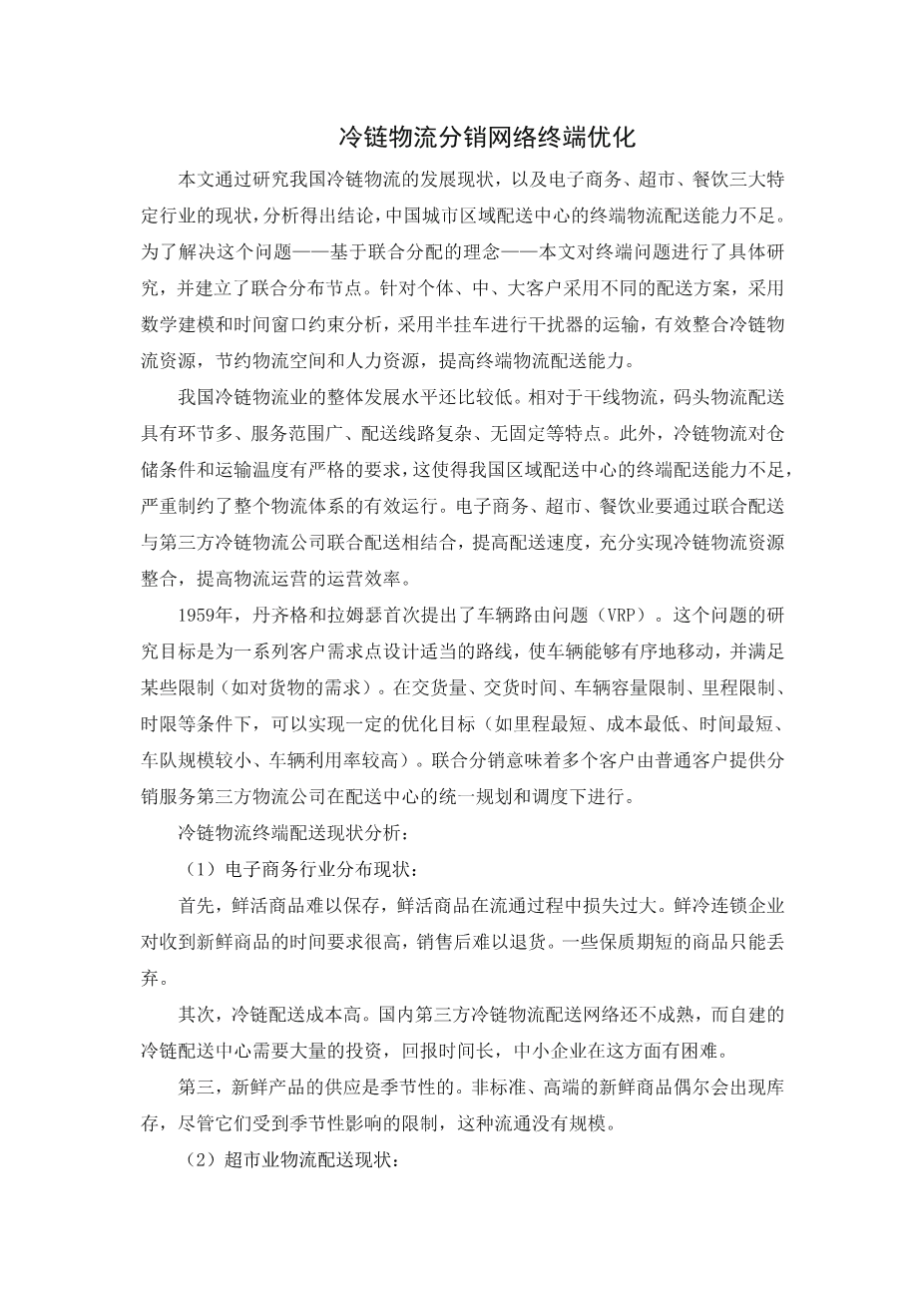By studying the development status of cold chain logistics in China, and the current situation in the three specific industries of electronics commerce, supermarkets, and the food and beverage industry, this paper analyzes and concludes that the terminal logistics distribution capacity of the regional distribution centers in Chinese cities is insufficient. In order to solve this problem—based on the idea of joint distribution—the paper makes a specific study of the terminal problem and establishes a joint distribution node. Different distribution schemes are adopted for individual, medium, and large customers, and we find that the semi-trailer is used to carry out the transportation of jammers by using mathematical modeling and time window constraint analysis, which can effectively integrate cold chain logistics resources, save logistics space and human resources, and improve terminal logistics distribution capacity.
The overall development level of the cold chain logistics industry in China is still relatively low. Relative to trunk logistics, terminal logistics distribution has many characteristics, such as many links, a wide service range, and complex and unfixed distribution lines . Moreover, cold chain logistics has exacting requirements for storage conditions and transportation temperature. This makes the terminal distribution capacity of the regional distribution centers of our country insufficient, and seriously restricts the efficient operation of the entire logistics system . The electronics commerce, supermarkets, and the food and beverage industry should be combined by using joint distribution [3], with the third-party cold chain logistics company distributing jointly to improve the speed of distribution, fully realize the integration of cold chain logistics resources, and improve the operational efficiency of the logistics operation.
The vehicle routing problem (VRP) was first raised by Dantzig and Ramser in 1959. The research goal of this problem is to design appropriate routes for a series of customer demand points, so that vehicles can move in an orderly manner, and meet certain constraints (such as the demand for goods). Under the conditions of delivery quantity, delivery time, vehicle capacity limit, mileage limit, time limit, etc., certain optimization objectives (such as the shortest mileage, the least cost, the least time, a smaller fleet size, and a higher vehicle utilization ratio) can be achieved. Joint distribution means that multiple customers are provided with distribution services by a common
third-party logistics company. It is carried out under the unified planning and dispatching of the distribution center.
Analysis of the present state of cold chain logistics terminal distribution:
(1) The current state of the distribution of electroniccommerce industry:
Firstly, it is difficult to save fresh goods, and there is too much loss of fresh goods in the course of circulation. A fresh cold chain business has high demands on the time of receipt of fresh goods, and difficulty in returning them after sale. Some goods with a short shelf life can only be abandoned.
Secondly, the cost of cold chain distribution is high.The domestic third-party cold chain logistics distribution network is not mature, while a self-built cold chain distribution center needs a very large investment with a long payback time. Small and medium enterprises have difficulty with this undertaking.Thirdly, the supply of fresh products is seasonal.Non-standard, high-end fresh goods occasionally occurout of stock, although they are limited by seasonal influence. This circulation has no scale .
(2) The present state of logistics distribution in supermarkets industry:
Firstly, there are too many self-distribution centers. Domestic supermarket chains like to build their own logistics centers, thus making it impossible for many distribution centers to meet the needs of supermarkets. Secondly, there is a wide range of goods with high distribution requirements. Supermarkets also find it difficult to find suitable distribution companies; as a result,
few supermarkets choose a third-party logistics distribution model. Thirdly, the proportion of a uniform distribution model is very low, and operation is difficult. At present, the proportion of a uniform distribution model is low in supermarket chains, leading to the high cost of cold chain logistics, and traditional logistics companies with single transportation and warehousing as the main business are difficult to adapt.
(3) The present state of distribution logistics in the catering industry:
Catering is mainly influenced by upstream food quality and product performance. Extending upstream industries can strengthen the control of product quality, while extending downstream industries can control the sales channels . The main reason for having too many food supply chain links is the lack of cold chain logistics, which is also a natural barrier to achieving standardization. Mass production can promote supply stability, while cold chain logistics can reduce circulation. More and more catering enterprises try to innovate their food supply chain by optimizing their supply chain management to reduce costs and improve distribution efficiency. Through analyzing the current state of the electronic commerce cold chain distribution, supermarket cold chain distribution, and the restaurant cold chain distribution, we conclude that the three industries have many problems in common .
Specific solutions for the cold chain endproblem, based on the idea of joint distribution.
The third-party cold chain logistics company carrying out joint distribution should coordinate the delivery time of the electronics commerce and supermarkets and the food and beverage industries, and the distribution routes and delivery methods should be chosen logically. Realizing the integration of resources would
剩余内容已隐藏,支付完成后下载完整资料
英语译文共 7 页,剩余内容已隐藏,支付完成后下载完整资料
资料编号:[258736],资料为PDF文档或Word文档,PDF文档可免费转换为Word
以上是毕业论文外文翻译,课题毕业论文、任务书、文献综述、开题报告、程序设计、图纸设计等资料可联系客服协助查找。
您可能感兴趣的文章
- 基于4P模型和品牌的路易威登中国营销策略分析外文翻译资料
- “互联网 ”背景下的电子商务对国际经济和贸易的影响外文翻译资料
- 四川达州农村电商生态系统建设中的问题与对策外文翻译资料
- 品牌年轻化策略对消费者购买意愿的影响研究外文翻译资料
- 后疫情时代咖啡企业新零售营销策略研究——以瑞幸为例外文翻译资料
- 中国精品咖啡电商市场营销研究 ——基于消费者行为视角外文翻译资料
- 基于社交网络的跨境电商用户购买行为影响因素的实验探索——以小红书为例外文翻译资料
- 基于数据仓库的培训机构信息管理系统的设计与实现外文翻译资料
- 支持在线学习环境和慕课中的自我调节学习:系统综述外文翻译资料
- 中日韩FTA对中国制造业的影响研究外文翻译资料




